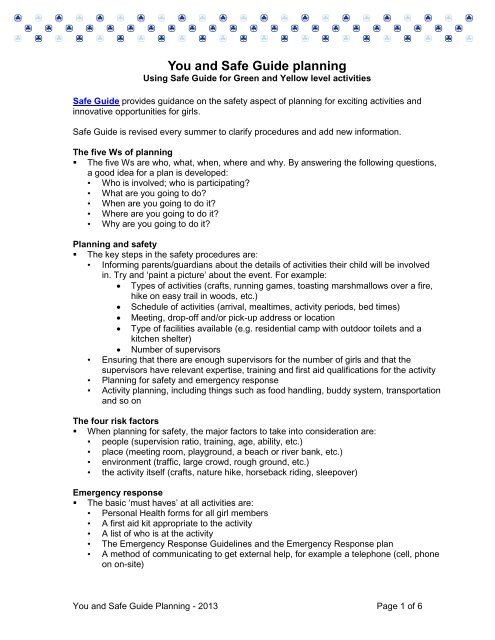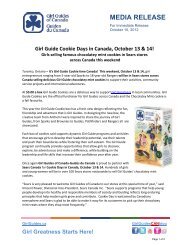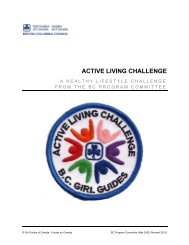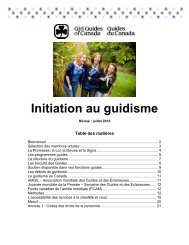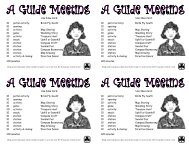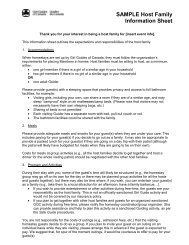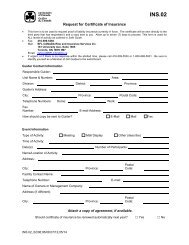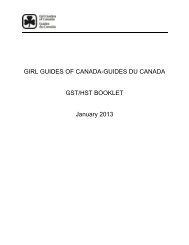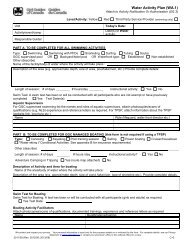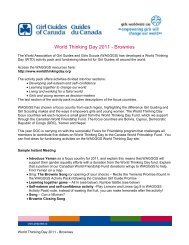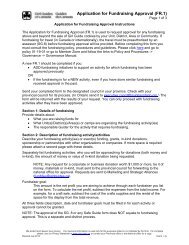Safe Guide 2008: Activity Planning and Safety Management ... - Forms
Safe Guide 2008: Activity Planning and Safety Management ... - Forms
Safe Guide 2008: Activity Planning and Safety Management ... - Forms
You also want an ePaper? Increase the reach of your titles
YUMPU automatically turns print PDFs into web optimized ePapers that Google loves.
You <strong>and</strong> <strong>Safe</strong> <strong>Guide</strong> planningUsing <strong>Safe</strong> <strong>Guide</strong> for Green <strong>and</strong> Yellow level activities<strong>Safe</strong> <strong>Guide</strong> provides guidance on the safety aspect of planning for exciting activities <strong>and</strong>innovative opportunities for girls.<strong>Safe</strong> <strong>Guide</strong> is revised every summer to clarify procedures <strong>and</strong> add new information.The five Ws of planning• The five Ws are who, what, when, where <strong>and</strong> why. By answering the following questions,a good idea for a plan is developed:• Who is involved; who is participating?• What are you going to do?• When are you going to do it?• Where are you going to do it?• Why are you going to do it?<strong>Planning</strong> <strong>and</strong> safety• The key steps in the safety procedures are:• Informing parents/guardians about the details of activities their child will be involvedin. Try <strong>and</strong> ‘paint a picture’ about the event. For example: Types of activities (crafts, running games, toasting marshmallows over a fire,hike on easy trail in woods, etc.) Schedule of activities (arrival, mealtimes, activity periods, bed times) Meeting, drop-off <strong>and</strong>/or pick-up address or location Type of facilities available (e.g. residential camp with outdoor toilets <strong>and</strong> akitchen shelter) Number of supervisors• Ensuring that there are enough supervisors for the number of girls <strong>and</strong> that thesupervisors have relevant expertise, training <strong>and</strong> first aid qualifications for the activity• <strong>Planning</strong> for safety <strong>and</strong> emergency response• <strong>Activity</strong> planning, including things such as food h<strong>and</strong>ling, buddy system, transportation<strong>and</strong> so onThe four risk factors• When planning for safety, the major factors to take into consideration are:• people (supervision ratio, training, age, ability, etc.)• place (meeting room, playground, a beach or river bank, etc.)• environment (traffic, large crowd, rough ground, etc.)• the activity itself (crafts, nature hike, horseback riding, sleepover)Emergency response• The basic ‘must haves’ at all activities are:• Personal Health forms for all girl members• A first aid kit appropriate to the activity• A list of who is at the activity• The Emergency Response <strong>Guide</strong>lines <strong>and</strong> the Emergency Response plan• A method of communicating to get external help, for example a telephone (cell, phoneon on-site)You <strong>and</strong> <strong>Safe</strong> <strong>Guide</strong> <strong>Planning</strong> - 2013 Page 1 of 6
Four steps to using <strong>Safe</strong> <strong>Guide</strong> for Green <strong>and</strong> Yellow levelactivitiesStep 1 – Make a planStep 2 – Review the <strong>Activity</strong> <strong>Planning</strong> Chart todetermine activity levelStep 3 – Check the <strong>Safe</strong> <strong>Guide</strong> procedures <strong>and</strong> <strong>Activity</strong><strong>Guide</strong>s or <strong>Planning</strong> <strong>Guide</strong>s <strong>and</strong> include them inyour planStep 4 – Implement the plan:• Green level GO AHEAD• Yellow level Get activity acknowledgement GO AHEADStep 1 – Make a plana) Start with the Five Ws of planning: who, what, when, where <strong>and</strong> why.Step 2 – Review the <strong>Activity</strong> <strong>Planning</strong> Chartb) Note where your activity falls in the chart. This will determine the activity level <strong>and</strong>planning for:• Permission from parents/guardians• Notification or authorization from GGC• Supervision ratios• First aiders• Emergency response planningb) Review the list of Key Terms for definitions <strong>and</strong> explanations of terms in this chart.NOTE:The chart assesses activities based on three levels:• Green level – simple, routine activities in the community• Yellow level – overnights <strong>and</strong> more complex activities that need more planning asthey involve more risk. GGC must acknowledge that these activities are beingundertaken.• Red level – require skill <strong>and</strong> training to supervise. They require a great deal offorethought to address <strong>and</strong> manage the risks associated with them. GGC mustauthorize these activities before they take place. This overview does not include thesteps for Red level activities.You <strong>and</strong> <strong>Safe</strong> <strong>Guide</strong> <strong>Planning</strong> - 2013 Page 2 of 6
Step 3 – Review the procedures <strong>and</strong> <strong>Activity</strong> <strong>Guide</strong>s or <strong>Planning</strong> <strong>Guide</strong>s <strong>and</strong>include them in your plana) Review the General <strong>Planning</strong> section <strong>and</strong> include applicable steps in your plan.NOTE:• The list of activities that are not permitted. These are in the Introduction to <strong>Safe</strong><strong>Guide</strong>. As these activities are not permitted, they are not insured.• Conditional Activities listed in Appendix B of <strong>Safe</strong> <strong>Guide</strong>. These activities have specialrequirements.• Age restricted activities listed under Pre-planning <strong>and</strong> <strong>Activity</strong> Levels.b) Use the relevant <strong>Activity</strong> <strong>Guide</strong>s <strong>and</strong> <strong>Planning</strong> <strong>Guide</strong>s to guide your planning. There are<strong>Activity</strong> <strong>Guide</strong>s for:<strong>Activity</strong> <strong>Guide</strong>s:• Accommodations• Activities in the Community• Activities in the Outdoors• Camping: Residential• Camping: Tenting in anEstablished Campsite• Cookie Sales• Horseback Riding• Ice Skating• Sledding/Tobogganing• Sleepover• Third Party Service Provider(TPSP)• Travel in Canada - 72 Hours orMore<strong>Planning</strong> <strong>Guide</strong>s:• Swimming• Boating• International Travel• Homestayc) Provide parents with details about activities, especially activities not held at the meetingplace. Use the <strong>Activity</strong> Plan (SG.1) form for activities that are outside of the meetingplace.Step 4 – Implement the planGREEN LEVELa) Emergency Response Plan (SG.4) –you must have an EmergencyResponse plan for regular meetings Go ahead!Tips for off-site meetings:• Complete an Emergency ResponsePlan specific to your off-site activity• Use the <strong>Activity</strong> Plan (SG.1) form whenparents/guardians need additionalinformation or need to do morepreparation. It will help you be sure thatyou have not forgotten any criticalinformation.OR YELLOW LEVEL1. Prepare these forms in the followingorder:• <strong>Activity</strong> Plan (SG.1)• Emergency Response Plan (SG.4)• Waiver (SG.5) if a Conditional<strong>Activity</strong>• Parent/Guardian Permission (SG.2)• <strong>Activity</strong> Notification or Authorization(SG.3)• TPSP Interview Checklist (SG.7) ifrequired2. Email/fax/mail these forms at least 14days in advance of your activity to theaddress for your province in Appendix Lof <strong>Safe</strong> <strong>Guide</strong>.You <strong>and</strong> <strong>Safe</strong> <strong>Guide</strong> <strong>Planning</strong> - 2013 Page 3 of 6
3. Distribute these completed forms toparents/guardians:• <strong>Activity</strong> Plan (SG.1)• Waiver (SG.5) if a Conditional<strong>Activity</strong>• Parent/Guardian Permission (SG.2)4. Obtain acknowledgement from assessor<strong>and</strong> attach to your copy of the SG.3 Go ahead – Have FUN!<strong>Safe</strong> <strong>Guide</strong> <strong>Forms</strong> for ActivitiesForm Purpose When to use<strong>Activity</strong> Plan (SG.1)Parent/GuardianPermission (SG.2)<strong>Activity</strong> Notification orAuthorization (SG.3)Emergency Response<strong>Guide</strong>lines <strong>and</strong> Plan(SG.4)• Assists in ensuring that the basics inyour planning are covered. Providescomplete details to parents/guardiansabout the activity, the facilities, theschedule, etc. It must be completed forYellow level activities.• Must be provided to parents/guardiansfor Yellow level activities along with the<strong>Activity</strong> Plan (SG.1). Together theyprovide the information thatparents/guardians use to decidewhether to give permission forparticipation in the activity.• Used to notify GGC of your intentions.It is sent for assessment. Before goingahead with your activity, you must havea response from an Assessor. ForYellow level activities, she can call youor email you with her acknowledgementof the activity. You must note herresponse on your copy of the form.• The Emergency Response <strong>Guide</strong>linesfound in Appendix H have basicemergency steps. To complete yourERP, you need to add proceduresspecific to your activity <strong>and</strong> locationusing the Emergency Response Plan(SG.4). You must have an EmergencyResponse Plan (SG.4) <strong>and</strong> the<strong>Guide</strong>lines with you at all activitiesincluding unit meetings. Make a copy ofthe SG.4 <strong>and</strong> <strong>Guide</strong>lines <strong>and</strong> put it in• Green level –optional• Yellow level -required• Yellow level• Yellow level• ALL Green <strong>and</strong>Yellow levelYou <strong>and</strong> <strong>Safe</strong> <strong>Guide</strong> <strong>Planning</strong> - 2013 Page 4 of 6
Release of Liability,Waiver of Claims,Assumption of Risk <strong>and</strong>Indemnity Agreement(SG.5)Third Party ServiceProvider InterviewChecklist (SG.7)Water <strong>Activity</strong> Plan(WA.1)Personal Health Form(H.1)Additional formsrelating to health,medication <strong>and</strong> first aidthe same place as you keep Health<strong>Forms</strong> <strong>and</strong> other materials that youbring to all activities.• Make sure everyone knows where it is.• Used for Conditional Activities <strong>and</strong>Adventure activities. These activitiesinvolve a higher degree of risk. Acondition of our insurance is that thisform is signed for all participants (girls<strong>and</strong> adults). Parents/guardians mustsign this form for girls under theprovincial/territorial age of majority.(Note that some activities run by a thirdparty also require the activity providerto provide proof of liability insurance.)More information about these activitiesis listed in <strong>Safe</strong> <strong>Guide</strong> Appendix B.• Used to interview a possible Third PartyService Provider (TPSP) <strong>and</strong> documentthe TPSP’s answers.• Required for some swimming <strong>and</strong>boating activities that are Yellow level.• Provides health information onparticipants, parent/guardian contactinformation as well as permission forpicking up a girl.• Personal Health Form for Adults (H.2).• Medication Plan <strong>and</strong> AdministrationRecord (H.3) – documents when girlstake their medication.• First Aid Treatment Record (H.4) –documents when first aid is given.• Wellness Statement (H.5) – used ifthere are concerns about managinghealth at an activity.• Yellow level forconditionalactivities:o Alpine/Downhillskiingo Boating with athird party serviceprovidero Horseback ridingo Scuba diving in apool• See the TPSP<strong>Activity</strong> <strong>Guide</strong> fordetails on when touse.• Yellow level• ALL activities• Used as needed forall activitiesInforming parents/guardians about Green level activities<strong>Guide</strong>rs must always make reasonable efforts to provide parents/guardians with informationabout the details of activities their child is involved in. For example:• Information on transportation (meeting place at the site, drop-off <strong>and</strong>/or pick-uplocation)• Personal kit list• Clothing for outdoor activities• Contact informationYou <strong>and</strong> <strong>Safe</strong> <strong>Guide</strong> <strong>Planning</strong> - 2013 Page 5 of 6
• Location• Meeting time• Description of the facilities• Details of activities taking place during the event (e.g. crafts, running games, hiking,tour of facility, etc.)• Schedule or itineraryPlease see the <strong>Safe</strong> <strong>Guide</strong> section on parent/guardian permission for more specifics on whatmust be provided.For Green level activities that are not at the regular meeting place, you will need to set up asystem for providing information to parents/guardians as well as a way of keeping track ofwho is coming.Here are a few tips to assist you with attendance at off-site activities:• <strong>Activity</strong> Plan (SG.1) – the activity plan is an excellent form to use for Green levelactivities when parents/guardians need additional information or need to do morepreparation. It will help you be sure that you have not forgotten any critical information.• Sign-up sheet – Several weeks before your off-site activity, you could post a sign-upsheet in a prominent place in your unit so parents/guardians can let you know if they areavailable to help by signing up as they arrive or before leaving a regular meeting.• Reminders – Send home a reminder <strong>and</strong>/or send an email. Older girls can assist inplanning by organizing a telephone/email system of reminders <strong>and</strong> let you know who willbe attending.• Attendance - You must always have a list of who is at an activity. This is a requirement ofthe Emergency Response Plan. Bring your unit roster with you <strong>and</strong> do a roll call or haveparticipants sign in as they arrive. Set up a buddy system.• Unit newsletter/group email – You may already have a unit newsletter that lists thedates, times <strong>and</strong> locations of upcoming activities. This is a great communication tool forall unit activities.You <strong>and</strong> <strong>Safe</strong> <strong>Guide</strong> <strong>Planning</strong> - 2013 Page 6 of 6


